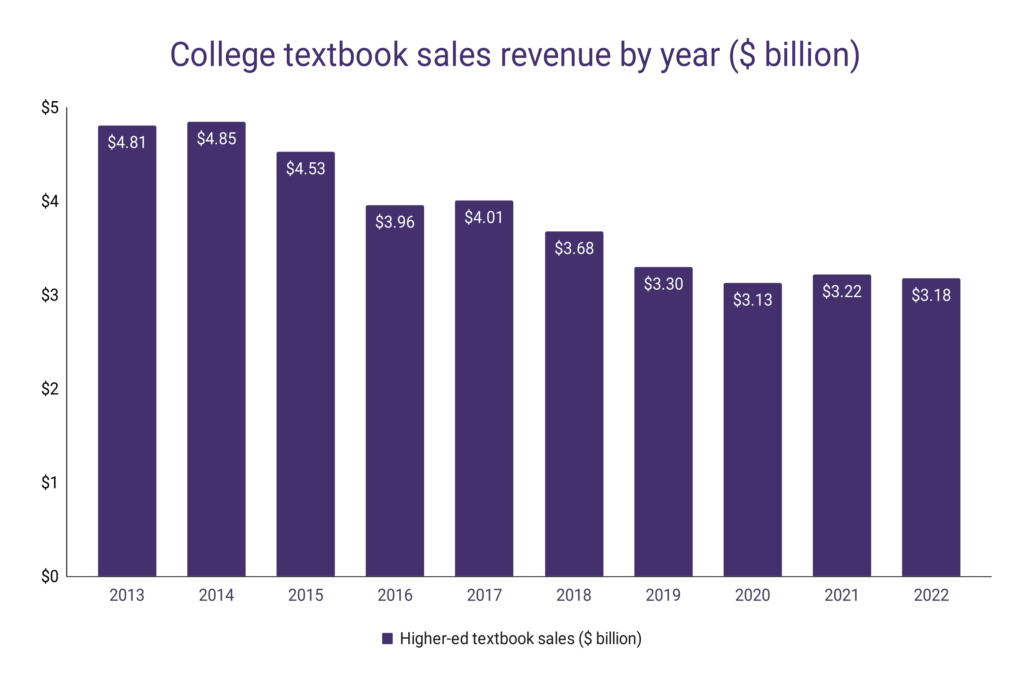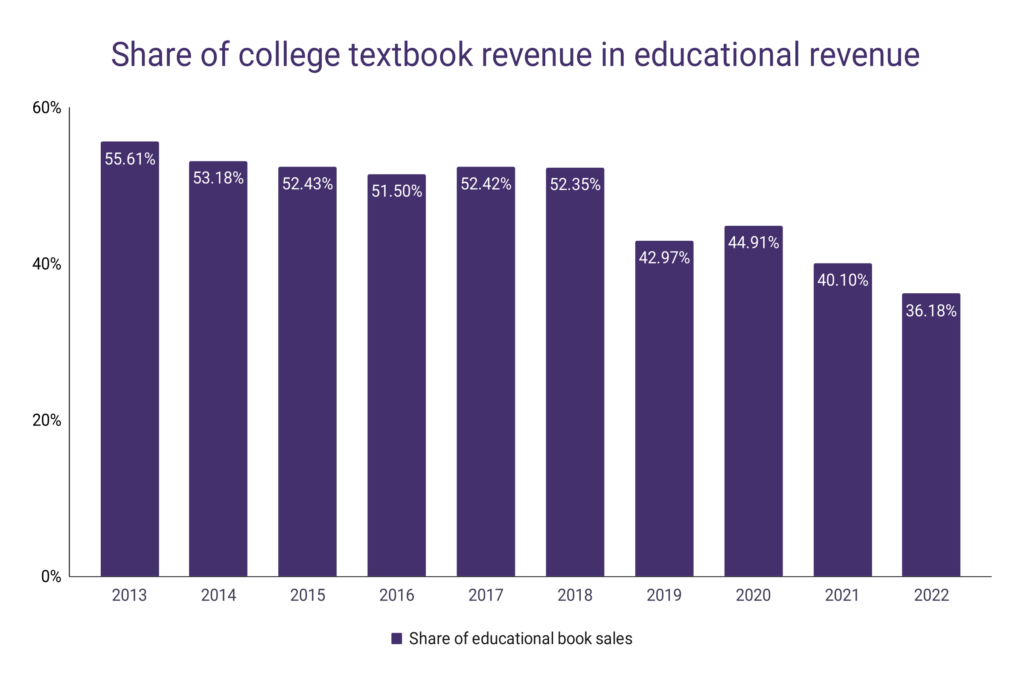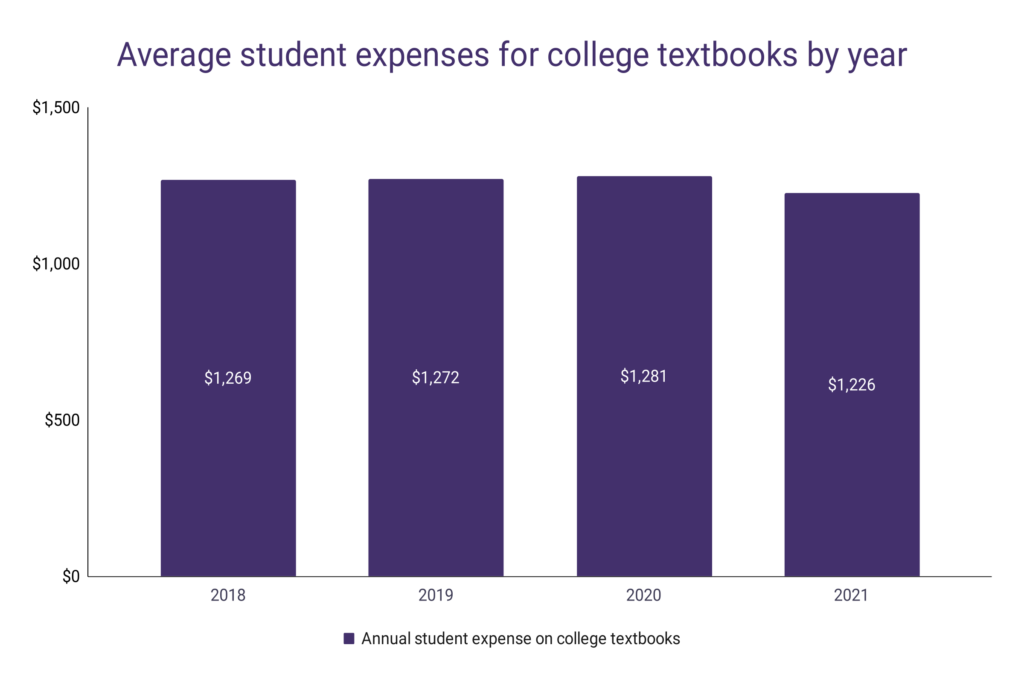Over 19 million students enroll in US colleges yearly in over 5,300 colleges and universities. While the number of US students has declined by 9.6% since 2010, higher education still plays a significant role in the publishing industry.
We compiled a report on the most interesting statistics about the higher-ed book industry and its changes over the years.
College textbook sales by year
- In 2022, higher-ed textbook sales in the United States generated over $3.18 billion in revenue.
- With a decline of 1.24% over 2021, the college textbook revenue in 2022 was the lowest annual revenue of this category over the last 9 years, excluding the pandemic-affected 2020.
- Overall, college textbook sales are down by over 34.94% compared to 2013, while the educational industry is up 1.62% over the same period.
- At the same time, the publishing industry overall has grown by 8.35% since 2013.
- This means that the higher-ed segment was the main reason behind the slower growth of educational book sales over the last decade.
| Year | Higher-ed textbook sales ($ billion) | Growth |
| 2013 | $4.81 | |
| 2014 | $4.85 | 0.83% |
| 2015 | $4.53 | -6.60% |
| 2016 | $3.96 | -12.58% |
| 2017 | $4.01 | 1.26% |
| 2018 | $3.68 | -8.23% |
| 2019 | $3.30 | -10.33% |
| 2020 | $3.13 | -5.15% |
| 2021 | $3.22 | 2.88% |
| 2022 | $3.18 | -1.24% |

College textbooks were the dominant revenue source for the educational industry until 2019, when the preK-12 segment took over:
- In 2022, higher-ed textbooks accounted for 36.18% of the educational book sales revenue in the United States.
- Only 4 years ago, in 2018, college textbooks accounted for over 52.3% of the industry’s revenue.
- In 2013, this segment controlled over 55.6% of the educational publishing market.
- Over the last 9 years, college textbooks’ share in the educational revenue has declined by over 34.94%.
- In 2022, college textbooks generated over $1.63 billion less than in 2013.
| Year | Higher-ed textbook sales ($ billion) | Educational books revenue ($ billion) | Share of educational book sales |
| 2013 | $4.81 | $8.65 | 55.61% |
| 2014 | $4.85 | $9.12 | 53.18% |
| 2015 | $4.53 | $8.64 | 52.43% |
| 2016 | $3.96 | $7.69 | 51.50% |
| 2017 | $4.01 | $7.65 | 52.42% |
| 2018 | $3.68 | $7.03 | 52.35% |
| 2019 | $3.30 | $7.68 | 42.97% |
| 2020 | $3.13 | $6.97 | 44.91% |
| 2021 | $3.22 | $8.03 | 40.10% |
| 2022 | $3.18 | $8.79 | 36.18% |
| Growth since 2013 | -33.89% | 1.62% | -34.94% |

The average price of college textbooks
While college expenses for the average US student, including tuition fees, are presenting a huge challenge for most students, the price of college books actually declined over the last few years:
- As of 2022, the average newly printed college textbook costs around $105.37.
- Considering the revenue from college book publishing, we can roughly estimate that over 29.42 million copies of college textbooks are sold during the year.
- The same estimation can suggest that the average US student will purchase only 2 newly-published textbooks during the year while seeking the rest on the second-hand or a digital book market.
- At the same time, the average US college student (in a public university) spends around $1,226 on textbooks.
- The average price of college textbooks is on a decline – dropping from $1,269 in 2018.
| Year | Annual student expenses on college textbooks | Change |
| 2018 | $1,269 | |
| 2019 | $1,272 | 0.24% |
| 2020 | $1,281 | 0.71% |
| 2021 | $1,226 | -4.29% |

- Overall, college textbook prices have been growing at a slower rate compared to the US industry average.
- Since 2013, the Consumer Price Index for college textbooks (CPI) has grown by 21.9%, while the overall CPI in the United States grew by 25.6%.
- From 2013 to 2018, college textbook prices grew by 20.29%, while overall prices in the US (measured through CPI) grew by 7.8%.
- Since 2019, the situation has been the opposite – college textbooks grew by only 3.8%, and the industry became 14.47% more expensive overall.
| Year | College textbooks CPI | CPI in the US |
| 2013 | 101.75 | 101.16 |
| 2014 | 105.73 | 102.80 |
| 2015 | 111.98 | 102.93 |
| 2016 | 118.15 | 104.22 |
| 2017 | 121.24 | 106.44 |
| 2018 | 122.39 | 109.04 |
| 2019 | 119.50 | 111.02 |
| 2020 | 117.66 | 112.39 |
| 2021 | 118.82 | 117.67 |
| 2022 | 124.05 | 127.09 |
| Change from 2013 to 2018 | 20.29% | 7.79% |
| Change from 2019 to 2022 | 3.80% | 14.47% |

- Over 29.7% of US public university students used some kind of financial aid to buy college textbooks.
- College ebooks are on the rise, as the spending on digital textbooks has increased by more than 156% over the last 10 years.
- Additionally, over 63% of students have skipped buying at least one required college textbook.
- At the same time, over one-third of college professors don’t know the real price of textbooks required for their classes when they choose them.
- Each new edition of a college textbook is over 12% more expensive than the previous one.
- Over 12% of Latinx college students fail a class because they weren’t able to buy textbooks, as opposed to only 5% of caucasian students.

